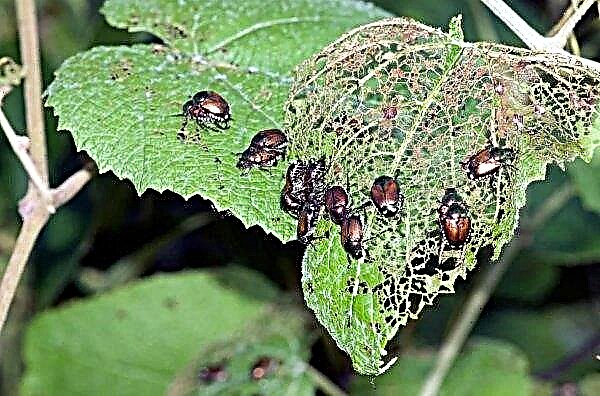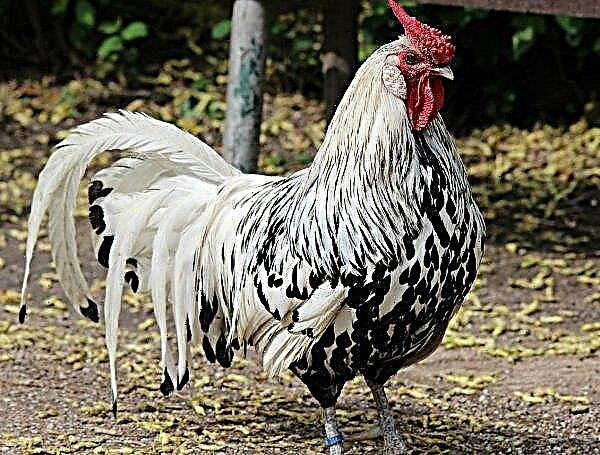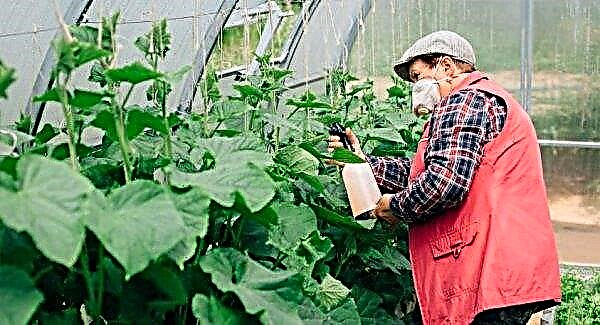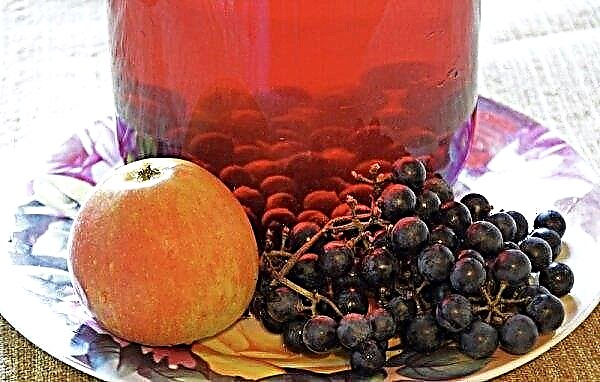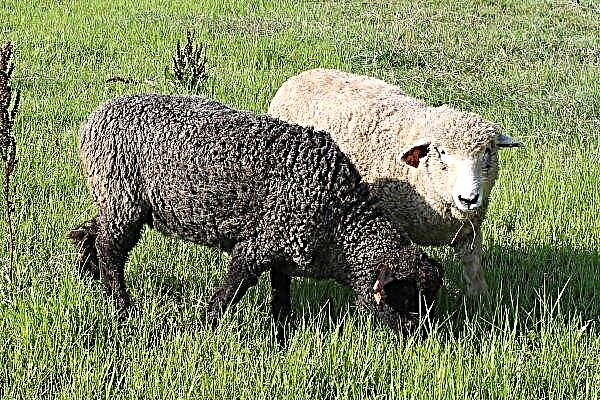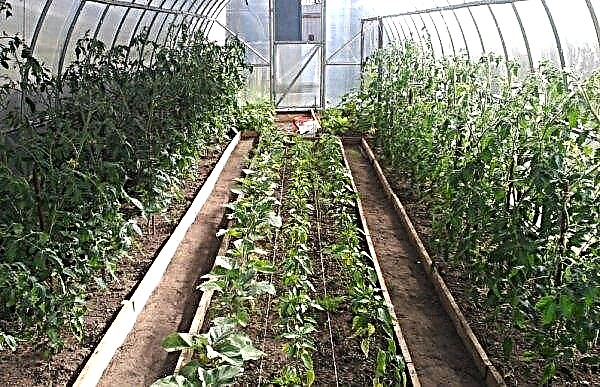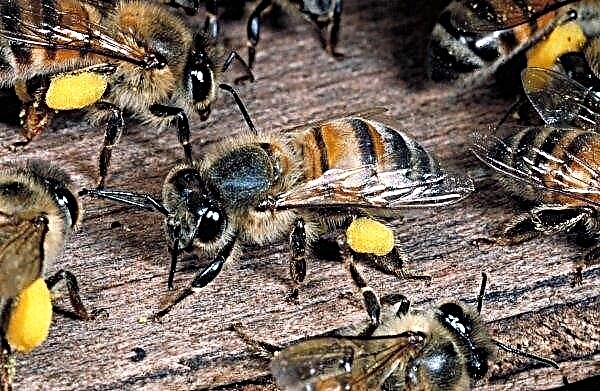Almost every year new varieties of roses appear, but there are those that remain popular for many decades. These are exactly the hybrid roses of Scarlet. We learn what these roses are, their origin and varieties, how they should be planted and grown.
Origin and description of the variety
Scarlet rose variety was bred more than 100 years ago. It was received by the famous rose breeder William Paul, putting in its basis another hybrid - Wichurana. Many gardeners are very fond of it, because its bright red double flowers collected in an inflorescence brush create a colorful touch in any design.
In this case, the variety is unpretentious, hardy and does not require pruning. It blooms luxuriantly and abundantly, bright flowers are emphasized favorably with dark green glossy foliage. Flowers over time from bright crimson, almost scarlet, become cherry. The bush has good growth power.
Did you know? A huge rose bush grows in the US state of Arizona. It has a trunk of almost 2 m in diameter and adorns an arbor of 8 m².
Varieties
Selection does not stand still, and today there are several varieties of Scarlet variety with spectacular red flowers and dark green glossy foliage.
Mayandecor
This variety is a scrub (semi-climbing rose), has a fountain-like appearance, sometimes it belongs to the ground cover group. On each peduncle, up to 10 scarlet semi-double flowers with a diameter of 3-4 cm are formed. Blossoms continuously throughout the summer and autumn. Variety Scarlet Meillandecor was bred in France in 1987 and is actively used in landscape design. The bush has a large growth force and grows up to 140 cm in height and up to 150–185 cm in width. Shoots during flowering wilt under the weight of flower brushes. The variety has other names - MEIkrotal, Scarlet Meidiland.
Variety Scarlet Meillandecor was bred in France in 1987 and is actively used in landscape design. The bush has a large growth force and grows up to 140 cm in height and up to 150–185 cm in width. Shoots during flowering wilt under the weight of flower brushes. The variety has other names - MEIkrotal, Scarlet Meidiland.
Ground cover
Scarlet Bonica is a novelty and has a rich red color buds. This is floribunda, which we attribute to ground cover varieties. It has high frost resistance, disease resistance and prolonged flowering.

It was bred by the famous French kennel "Meilland" in 2015. The bushes are compact, 50–100 cm high. Scarlet flowers with a diameter of 5–10 cm are collected in small inflorescences (3–5 pcs.). The official name is Scarlet BONICA (AM 210, Canyon Road, MEIscarlebo).
Paul
This is a climbing rose, which was first introduced in 1916 and has the official international name Paul's Scarlet Climber. We still meet her under the name Paul Scarlet. It has bright red flowers with a diameter of about 7 cm, collected in brushes of 3-5 pieces. The variety blooms very luxuriantly, but only once a season, usually in early summer.

Repeated flowering is absent, and if it occurs, then only in the southern regions and very weakly. At this representative of roses, lashes grow up to 3 m, it is used for landscaping walls, fences, arbors and arches. The variety is classified as climbing floribunda. It is unpretentious, can grow on poor soils, is winter hardy.
Hit
Variety Scarlet Heath (Scarlet, POULmo, Scarlet Hit, Ruby Wishes) was bred in Denmark in 1987. It belongs to the roses of the patio (or miniflora), being, in fact, stunted roses of the floribunda. Their height is only 40-60 cm, so they are great for landscaping borders, flower beds, creating low boles. Small ruby roses (about 4–5 cm) bloom continuously and after flowering they crumble.

Features of planting and growing
Roses Scarlet prefer sunny places, although they can grow in partial shade. Cold winds at the landing site should be absent. Like all roses, they grow well on nutritious and well-permeable soils with an acidity of 5.6–7.3 pH.
Loams are well suited to these shrubs. There should be no stagnation of water or close occurrence of groundwater at the landing site. If the soil is too heavy, then sand is added to it, and if sandy, organic matter and clay are added.Important! Too acidic soils are alkalized with liming, and manure and peat are introduced into alkaline soils..
Rose planting is carried out when the earth warms up enough, tentatively in May. The ideal temperature of air and soil for roses is a range of + 17 ... + 20 ° C. In this mode, the bushes will take root and grow well. In the southern regions, roses can be planted in the fall in warm, dry weather, when the air humidity is around 80% and the temperature does not drop below + 5 ... + 10 ° C at night.

They dig a planting hole of such a size that it can freely place a seedling in it and spread its roots. If necessary, drainage should be made from crushed stone or sand, since roses do not tolerate stagnation of water. For planting, it is recommended to make the following nutrient mixture: mix manure, a fertile layer of land, sand and peat in a ratio of 3: 2: 2: 1.
Roses need about 600 mm of rain annually. They do not like strong summer heat (above + 30 ° C), therefore they require watering on hot days. Varieties of Scarlet are classified as winter-hardy, but in harsh winters it is better to shelter them.
Home Care
All Scarlet roses are considered unpretentious, but this does not mean that they do not need to be taken care of.
Watering
Scarlet rose bushes are watered as the soil dries (about once a week). Bushes are watered infrequently, but plentifully - about 10 liters of liquid under 1 adult plant. Watering should be done in the morning or evening. In the heat should be watered more often: up to 3 times in 7 days. The stream of water from the hose should not be strong so as not to erode the root system of the plant.
Important! It is worth considering that young seedlings should be watered more often until they get stronger. Due to drying out, the young plant may die.
It is better to water the earth around the bush so that the spray does not fall on the leaves and flowers. Water for irrigation should be at room temperature. In the large rose garden in summer, you need to install an irrigation system with a sprayer. In the autumn, watering is reduced so as not to provoke the appearance of fungal diseases, but the roots should not dry out.
Fertilizer application
When planting rose bushes, it is necessary to fertilize. For this purpose, the drug “Citovit” is perfect.

Adult bushes should be fertilized at least 3 times in a warm period:
- First feeding carried out in April, approximately 14 days after the appearance of leaflets. For this purpose, nitrogen fertilizers are used. A slurry from manure or bird droppings is well suited. To do this, manure (litter) is dried, then diluted with water in a ratio of 1: 4, let it brew for a couple of days. After that, 1 liter of this infusion is diluted with a liquid in an amount of 10 liters.
- Second time top dressing is introduced from late May to early June 21–28 days after the first top dressing. To do this, use complex fertilizers. A mixture of 1 part potassium, 2 parts phosphorus, 1 part nitrogen is a good fit. You can use ready-made complex dressings such as "Kemira wagon."
- Third feeding spend in early September. For this purpose, apply phosphorus-potassium fertilizers.
Pruning
On the new shoots of this year, the Scarlet rose forms only a few buds, so most of the flowers are formed on the stems of past years. Flower growers do not recommend pruning before the winter season. In autumn, pruning of old shoots aged 5–6 years is allowed.

But at the beginning of spring, before the awakening of the buds, be sure to trim the bush after harvesting for the winter. All damaged and dried branches are cut to a healthy part. In the summer, formative pruning is performed as necessary. In this case, shoots that have already bloomed are cut.
Important! The tool for trimming the bush (garden shears, nippers) should be well sharpened so as not to severely injure the plant. At the same time, it should be disinfected with a solution of potassium permanganate. At the cut of the plant, it is necessary to carry out treatment with garden var.
Transfer
Sometimes when replanning a site, it is necessary to transplant an adult plant from place to place. This procedure is best done in spring or autumn. First you need to choose a place with optimal conditions and prepare a planting pit (as for planting a new seedling).
Before transplanting, the plant needs to be watered, branches tied to ease its approach to the bush. If this is done in the summer, then the rose bush should be pruned, leaving only 40-50 cm in height, removing unripe shoots and buds.

An adult plant is dug up while preserving the largest amount of earthen coma, i.e., by transshipment. To do this, the bush is dug up around the perimeter, it is taken out of the ground and then the roots with a lump of soil are placed in polyethylene. Too long roots that interfere with digging will have to be cut.
After that, the plant is transferred to a new planting pit, half-covered with soil, a film is removed from a coma, the bush is placed in a new pit, watered, the remaining soil is covered, and watered again. After all the moisture is absorbed into the ground, the soil around the bush is rammed. For better root engraftment, Zircon can be used.
Did you know? During the War of the Scarlet and White Roses (the Civil War in England), the name “War of the Roses” was not used, but was given later by historians. During this confrontation, roses were the hallmarks of two warring parties.
Growing difficulties
When growing Scarlet roses, in violation of agricultural technology or the occurrence of unfavorable external factors, one may encounter some difficulties.
So, in this rose, such pests and diseases may appear:
- Powdery Mildew It is detected by the appearance of whitish spots on the leaves and stems. To combat such a nuisance, the damaged parts should be cut and disposed of, and then the bush should be treated with copper sulfate or Bordeaux liquid.

- Black spotting. The disease can be detected by brown-brown spots on the leaves, as well as branches. To eliminate the problem, the affected areas should be removed and burned, and then sprayed with Bordeaux fluid.

- Bacterial cancer. A sign of this disease is brownish spots, which over time become larger in size. Unfortunately, in this case, the bush needs to be dug up and disposed of, since there are no effective remedies for this disease. In order to prevent, in order to prevent the occurrence of this ailment, rose seedlings before planting in a permanent place should be treated with copper sulfate.

- Rust. Revealed in the form of rusty seals on the bottom of the leaves. To combat, spraying is used with Bordeaux liquid or with Fundazol solution. For the purpose of prevention, they are treated with immunomodulatory drugs and systemic fungicides.

- Spider mite. This pest can be detected by the appearance of a thin cobweb on the leaves, as well as light spots on them. You can get rid of the spider mite with the help of the Aktara or Fitoverm insecticides. For prevention purposes, it is possible to treat bushes with infusion of onion husks. The smell of marigolds, calendula, tansy planted nearby will scare away these pests.

Roses Scarlet are unpretentious, easy to care for and yet unusually beautiful. In some varieties, their bright red flowers delight with their flowering throughout the summer and even in autumn.






